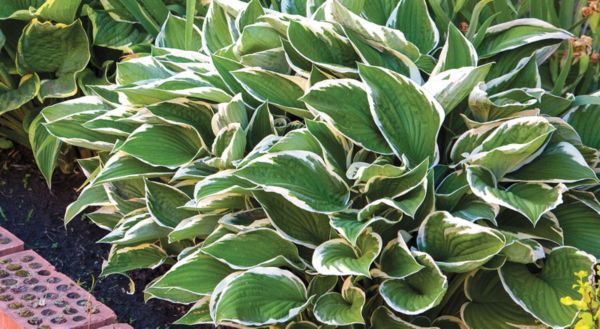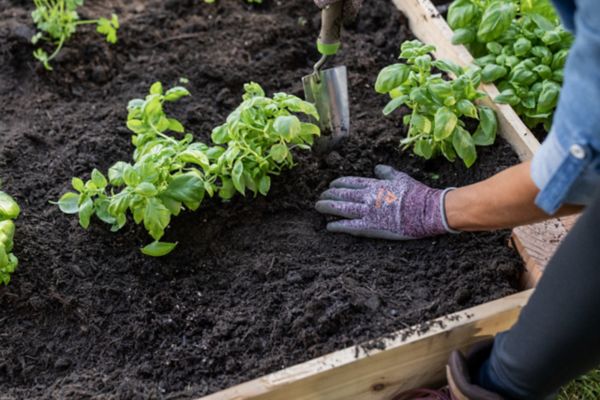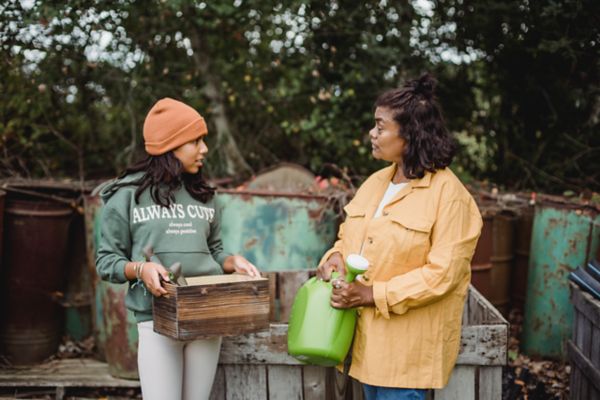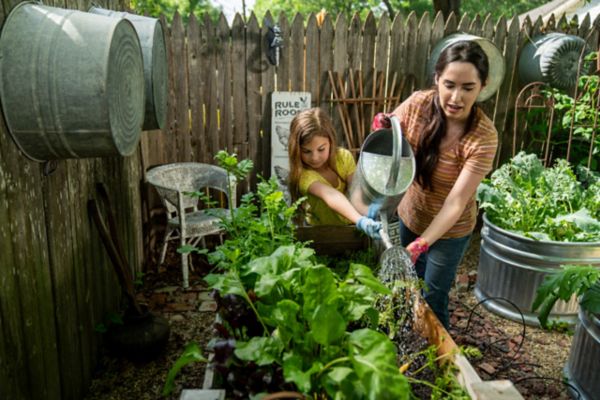How to Grow Lavender
Authored by Leah Chester-Davis
Lavender oil is prized as an ingredient in soaps, perfumes, and lotions. The flowers and flower buds are used in sachets and potpourris. It also is used in savory and sweet culinary dishes. Whether you grow it for these uses or to simply add beauty to the landscape, this herb with reward you with pretty blooms and fragrance.
Lavender is a showy herb that grows in a mound and sends up spires of purple or lavender-colored blooms, hence the name, though some varieties are white or pink. It has needle-like foliage that is silvery grey to blue green.
Lavender thrives in sandy, well-drained, dry, Mediterranean-like temperatures. Iconic photos of this crop are often from the Provence region of France where the soils and the climate result in striking purple fields, drawing visitors from around the world. Though it may not be as easy to grow in many regions of the United States, there are lavender farms throughout. Typically, it blooms from June through August though Spanish types begin blooming in the spring and through the summer.
Lavender can be grown in containers, raised beds, or in the landscape if there is good drainage. Its airy, colorful spikes and its distinctive, soothing scent make it a great addition to a patio or cottage garden, tucked into borders with other perennials and roses, or as an plant in an herb garden. It can even be grown as a small hedge. Place near a walkway or patio to enjoy its scent.
About lavender
| Botanical name: | Lavandula |
| Common name: | Lavender |
| Plant type: | Semi-woody perennial subshrub |
| Size: | 1- to 3-feet tall, depending on variety |
| Sun exposure: | Full sun |
| Soil type: | Prefers sandy loam; well-drained soil |
| Soil pH: | Alkaline, 6.5 to 7.5 |
| Hardiness zones: | 5 to 10 |
| Average first frost: | Varies by region |
| Average last frost: | Varies by region |
| Container friendly: | Yes |
| Beginner friendly: | Yes |
Growing
Lavender thrives in full sun, at least 6 to 8 hours per day. It must have well-drained soil and prefers sandy loams or gravelly or rocky soil.
Recommended soil pH is 6.5 to 7.5. A soil test, available from your county Extension office, is the best way to determine pH and to receive recommendations for what your soil may need. If starting with acidic soils, Michigan State Extension recommends applying 1/8 cup of lime per square foot on the soil surrounding the plants.
Lavender is not a fan of heavy soils. Colorado State Extension recommends amending the soil with one-quarter-inch bark mulch to facilitate drainage. Apply one inch of the mulch and till it to a depth of 6 to 8 inches.
It does not like water-logged or wet soils, which will contribute to a shorter life for the plant. It also is not a fan of humid climates though it will grow there.
Lavender needs good air circulation between the plants. Do not crowd it.
Types of lavender
When purchasing lavender plants, you will likely come across a few different types. University of Vermont Extension provides information on each and some popular cultivars.
English lavender
Lavandula angustifolia, is one of the most widely grown. It grows in a wide range of zones, typically 5 to 10. ‘Munstead’ has blue-purple flowers, ‘Hidcote’ has dark blue flowers, and ‘Jean Davis’ has light pink flowers.
Spanish lavender and French lavender
L. stoechas and L. dentata, are often called non-English types. Spanish lavender grows better in warmer, high humidity climates, Zones 7 to 9, than other lavenders. It may not overwinter well. A newer French hybrid, ‘Phenomenal’, is being touted for its outstanding cold hardiness and its tolerance to heat and high humidity. It deep blue to purple flower spikes.
Lavendar cultivars
“Lavandins” are a cross of the English species and Portuguese (L. latifolia). They are hardy even in cooler climates like Zone 5. ‘Grosso’ with dark purple flowers and ‘Provence’ with purple flowers are popular choices. ‘Edelweiss’ has white flowers.
Lavender thrives in sandy, well-drained, dry, Mediterranean-like temperatures.
Planting
Lavender can be grown from seeds though it is slow to germinate and is not the best option for home gardeners. If you insist on this route, plant 1/8-inch deep in a soilless mix. Do not allow it to dry out. Lavandins must be grown from cuttings because they are sterile. Small plants typically can be purchased from a local garden center and will be the quickest way to enjoy this plant in containers or in your garden.
If you have an established lavender plant, you can take cuttings from it to propagate. Take cuttings after the plant has bloomed. Cut below a leaf node, remove the leaves from the bottom half of the cutting, dip in a rooting hormone, and place the cuttings in sterile potting soil to get started. Keep them moist but not wet. They will root in about a month. Transplant to a 4-inch pot. When the cuttings have developed a root system, transplant to the garden.
Plant in either spring or fall. Spring may be best in cooler climates to allow the plant to establish a good root system before winter. In warmer regions or hot climates, fall may be best. If planting in spring, plant after danger of frost has passed. If planting in fall, plant lavender that is at least 4-inches tall with a good root system and allow time (around 2 months) for the plant to get established before cold weather.
If planting rows of lavender, space the plants 18- to 24-inches apart or more, depending on the size of cultivar. Allow 3 to 6 feet between rows. Plant in soil that has been worked and amended to the preferred pH levels
If planting in containers, lavender does well on its own. If adding other plants, choose ones that also prefer full sun and well-drained soil. Keep your growing beds or containers free of weeds for best growing conditions.
Lavender benefits from mulches but not the typical wood mulches that are used around many plants. For lavender, Illinois Extension recommends rock or pea gravel. This will help keep the crown dry and prevents excess moisture from causing foliar diseases. Avoid wood mulches, which can retain too much moisture.
Maintain even water levels while the plant is becoming established. Water about every 5 days in absence of rainfall and allow the plant roots to dry out between watering. It may need to be watered more frequently if in a container. Water at the base of the plant or use drip irrigation to keep the foliage dry. When established, lavender is drought tolerant.
During the winter, particularly in colder climates, lavender will need to be mulched to help protect it. Straw or evergreen boughs are good options.
During the first year, clip the branches to keep them from flowering. This encourages the development of lateral shoots and will result in fuller plants in subsequent years.
Lavender benefits from light, yearly pruning. It flowers on new growth, so it is best to prune established plants lightly in the spring when green leaves begin to appear at the base of the plant. Prune no more than one-third of the plant. Remove any winter-damaged stems. Shape into a mound shape. Pruning helps keep the plant from splitting open and becoming too woody.
Fertilizing
Lavender does not require heavy feeding of fertilizer. If compost is mixed into the soil at the time of planting, it likely will not need more fertilizer during the first year. In subsequent years, add more compost around the plants.
If adding fertilizer, Utah State Extension recommends one application (1 tablespoon per plant) of slow-release fertilizer for the entire growing season. An organic option is liquid seaweed, fish emulsion, or bone meal a couple of times during the growing season. Follow label directions.
Controlling Pests, Diseases, and Other Problems
This plant does not have a lot of pest or disease problems. Rabbits usually steer clear of the plant and so do deer. The plant’s oils act as a repellent.
It does not like wet conditions, which can make it more susceptible to root-rotting diseases. Good drainage is essential to avoid these problems.
During the first year, clip the branches to keep them from flowering. This encourages the development of lateral shoots and will result in fuller plants in subsequent years.
Harvesting and Storing
Cut lavender stems just as the flowers start to open. If you plan on drying lavender, harvest before flowers have fully opened. This is usually when the scent is most fragrant.
Harvest in the morning after the dew has dried or evaporated.
Lavender flowers can be dried on the stem. Gather the stems or stalks in bunches and tie together or secure with rubber bands. Hang upside down in an area that is dry, dark, and dust-free.
Storing
The dried, full stems can be stored in containers with tight-fitting lids. The buds can be stripped from the plant for potpourris and sachets.
Expert Tips
- It is easier and quicker to start plants by propagating cuttings rather than starting seeds.
- With the proper growing conditions, and in arid climates like parts of the Southwest and West, lavender plants last 10 to 15 years. It typically does not live as long in hot and humid climates like the Midwest and Southeast but that should not deter you from growing this beautiful plant.
- Control weeds to give lavender its best chance to thrive. It will not perform well if it must compete with weeds.
- When growing with other ornamental plants, site lavender near plants that have similar water requirements such as salvia, echinacea or rudbeckia.
Frequently asked questions
What is the best lavender to grow in my region?
This is a good question and the answer depends on where you are located. Our best advice is to check with your county Extension office or with a local herb association to find out best types and varieties for your region. Generally, English lavenders may be difficult to grow in hot and humid climates. A Spanish lavender may be best in this case. Conversely, if you are in a cold climate, you may want a lavender that can withstand cold temperatures. Some of the lavandins may be options. Another plant to consider is a newer hybrid, ‘Phenomenal’, which has been developed to handle extremes at both ends of the temperature gauge.
Is lavender a good plant to attract pollinators?
Yes, it is a pollinator magnet! Both bees and butterflies love lavender.





